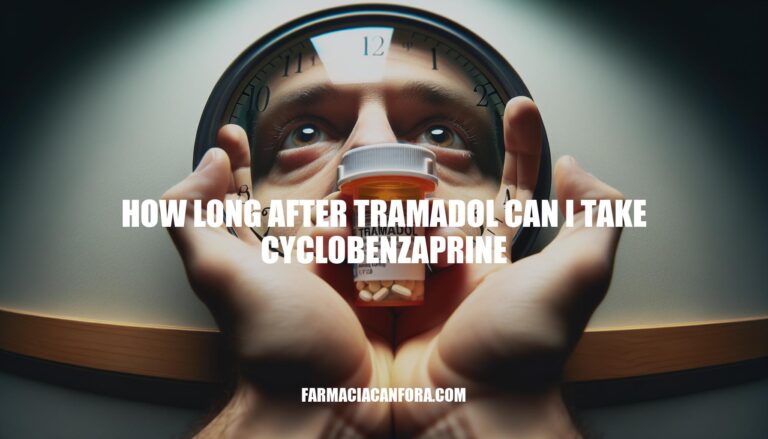


Understanding the timing for taking tramadol-can-i-take-flexeril”>cyclobenzaprine after tramadol is crucial for patient safety. Both medications can depress the central nervous system, and taking them too closely together can increase the risk of severe side effects such as respiratory distress, coma, or even death. Proper timing helps mitigate these risks, ensuring that patients can safely benefit from both medications without experiencing harmful interactions. Always consult with a healthcare provider to determine the safest schedule for taking these medications.
Tramadol is an opioid analgesic used to treat moderate to moderately severe pain. It works by binding to opioid receptors in the brain and inhibiting the reuptake of serotonin and norepinephrine, which helps to change how your body feels and responds to pain.
The effects of tramadol typically last for about 4 to 6 hours. However, it can stay in your system for a longer period, with a half-life of approximately 6 to 7 hours. This means it can take about 1 to 2 days for tramadol to be mostly eliminated from your body.
Cyclobenzaprine is a muscle relaxant used to relieve muscle spasms associated with acute, painful musculoskeletal conditions. It is typically prescribed for short-term use, often in conjunction with rest and physical therapy.
Mechanism of Action: Cyclobenzaprine works by acting on the central nervous system, specifically the brainstem, to reduce muscle hyperactivity. It blocks nerve impulses or pain sensations sent to the brain, helping to relax muscles.
Timing with Tramadol: It’s crucial to manage the timing when taking cyclobenzaprine after tramadol due to the risk of central nervous system depression. Both medications can cause drowsiness, dizziness, and sedation. Taking them too closely together can amplify these effects, potentially leading to severe drowsiness or respiratory depression. Always follow your healthcare provider’s instructions regarding timing and dosage to avoid adverse interactions.
Combining tramadol and cyclobenzaprine can lead to several serious interactions:
Central Nervous System (CNS) Depression: Both medications have CNS depressant effects. When taken together, they can significantly increase the risk of severe drowsiness, respiratory distress, coma, and even death.
Serotonin Syndrome: Tramadol increases serotonin levels, and cyclobenzaprine can also affect serotonin. Using them together raises the risk of serotonin syndrome, a potentially life-threatening condition characterized by symptoms such as agitation, hallucinations, rapid heart rate, fever, excessive sweating, shivering, muscle stiffness, and loss of coordination.
Other Serious Side Effects: The combination can also lead to other severe side effects like impaired thinking and judgment, dizziness, and difficulty concentrating. These effects can be exacerbated by alcohol or other CNS depressants.
It’s crucial to consult a healthcare provider before using these medications together to manage the risks effectively.
Combining tramadol and cyclobenzaprine can lead to serious side effects, including respiratory distress, coma, and even death due to their central nervous system depressant effects. Medical professionals generally advise against taking these medications together without close monitoring.
Guidelines from Medical Professionals:
Relevant Studies and Recommendations:
Always follow your healthcare provider’s advice and report any unusual symptoms immediately.
Here are the factors that can influence how long after taking tramadol one can take cyclobenzaprine:
Always consult with a healthcare provider for personalized advice.
It’s crucial to consult your healthcare provider before taking cyclobenzaprine after tramadol due to potential serious interactions, including increased risk of seizures and respiratory distress.
Questions to Ask Your Doctor:
Information to Share with Your Doctor:
Always keep your healthcare provider informed to ensure your safety and well-being.
When taking tramadol and cyclobenzaprine together, it’s crucial to manage the timing due to the risk of central nervous system depression. Both medications can cause drowsiness, dizziness, and sedation, which can be amplified when taken too closely together.
This combination can lead to severe side effects such as respiratory distress, coma, or even death. Always consult with a healthcare provider before using these medications together to determine the safest schedule for taking them. They may adjust doses or suggest alternatives and recommend frequent monitoring to manage potential interactions.
It’s also essential to avoid alcohol while taking these medications, as it can exacerbate side effects. Factors such as dosage, individual metabolism, overall health condition, age, concurrent medications, and alcohol use can influence how long after taking tramadol one can take cyclobenzaprine.
Always follow your healthcare provider’s advice and report any unusual symptoms immediately.